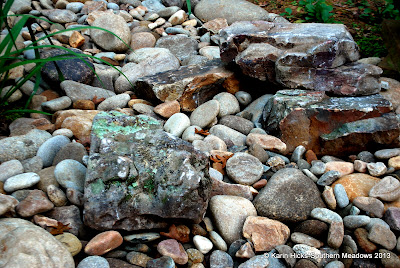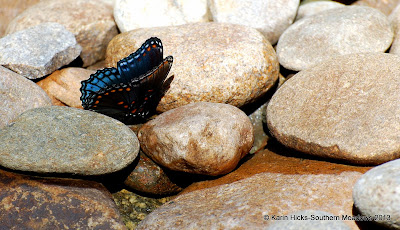Planting Rocks
Have you ever planted rocks in your garden? I am sure you have because this is the kind of crazy thing we gardeners do! Having a flatbed of rocks delivered is normal, right?
Seven pallets of rocks and 2 pallets of flag stone were delivered last week and my husband got started on the dry creek bed right away. He was as excited about this project as I was.
We choose medium to large size smooth rocks to give the dry creek bed a natural look and visual appeal. Smaller river rock was used to fill in between the larger rocks.
This is the top (beginning) of the bed where we started with larger rocks mixed with the smooth medium and small river rock. I love that some of the large rocks already have lichen growing on them!
I had already planted some irises and pink muhly grass near the edge of the dry creek bed. We found that this worked really well. Adding plants after the rock was spread would be much more cumbersome.
Rocks, just like plants, support many forms of life. Turn over a rock and you might find a worm, ant, centipede, beetle, spider, toad or a number of other soil organisms. They may be way down there on the food chain but they are a very essential part of any garden.
Almost immediately upon laying rocks the insects arrived. Several butterflies, bees, and flies checked out the new garden addition. And guess what...they approved!
The butterflies used the rocks to bask in the sun and perch on while they reached between the rocks to find the essential minerals they need.
Birds, snakes, lizards, spiders and other mammals will hunt for food in these rocks. We used two man boulders to make a smoother transition from the rock bed to the moss garden area. I think the wildlife will appreciate it.
Not only will the rocks provide a beneficial micro-climate for garden insects and plants, but from a design perspective they offer a nice transition between the architecture of our home and garden. Remember this area before? I mentioned this area in my Seasonal Celebrations: Autumn post.
This is how it looks now. We still have some plantings to add around the perimeter and mulch but I couldn't be happier with the result.
The leaves are falling onto the rocks, the critters are moving in and the rocks look like they've always been planted here.
Building a dry creek bed, finishing a few pathways and adding some decorative rock to our garden were several of the projects on our fall to do list this year. So a few weeks ago, we visited our local rock yard to pick out rocks. This was really tough because I love rocks. Is that weird? I would buy them all but alas that isn't in the budget. We narrowed our choices down, first by style, then size, then color and then it was just a matter of preference. Sounds easy enough, right. But it took a lot of thought and serious decision making with all the irresistible choices.
Seven pallets of rocks and 2 pallets of flag stone were delivered last week and my husband got started on the dry creek bed right away. He was as excited about this project as I was.
We choose medium to large size smooth rocks to give the dry creek bed a natural look and visual appeal. Smaller river rock was used to fill in between the larger rocks.
This is the top (beginning) of the bed where we started with larger rocks mixed with the smooth medium and small river rock. I love that some of the large rocks already have lichen growing on them!
I had already planted some irises and pink muhly grass near the edge of the dry creek bed. We found that this worked really well. Adding plants after the rock was spread would be much more cumbersome.
Rocks, just like plants, support many forms of life. Turn over a rock and you might find a worm, ant, centipede, beetle, spider, toad or a number of other soil organisms. They may be way down there on the food chain but they are a very essential part of any garden.
Almost immediately upon laying rocks the insects arrived. Several butterflies, bees, and flies checked out the new garden addition. And guess what...they approved!
The butterflies used the rocks to bask in the sun and perch on while they reached between the rocks to find the essential minerals they need.
Birds, snakes, lizards, spiders and other mammals will hunt for food in these rocks. We used two man boulders to make a smoother transition from the rock bed to the moss garden area. I think the wildlife will appreciate it.
Not only will the rocks provide a beneficial micro-climate for garden insects and plants, but from a design perspective they offer a nice transition between the architecture of our home and garden. Remember this area before? I mentioned this area in my Seasonal Celebrations: Autumn post.
This is how it looks now. We still have some plantings to add around the perimeter and mulch but I couldn't be happier with the result.
The leaves are falling onto the rocks, the critters are moving in and the rocks look like they've always been planted here.













.png)
